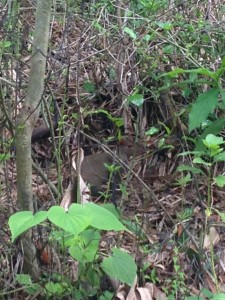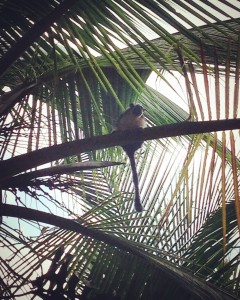It’s only our second day here in Gamboa, Panama, and I think everyone is awe of the amazing biodiversity surrounding us! It seems like as soon as we step outside of our schoolhouse here at STRI, there’s a beautiful array of tropical fauna- ranging from tall palms and gracefully draping lianas (a type of woody vine), to incredibly vibrant flowers and a plentiful number of mangos. Yesterday, we all took turns taking a bite out of an almost-ripe mango and learned one thing: when mangos aren’t quite ripe, they’re very fibrous and you WILL have mango stuck in your teeth all day (like I did)…so be forewarned.
Here’s a taste of the beauty that is Panama:
As beautiful (and tasty) as all of this plant life has been, I can’t help but favor our experiences with the animals of Gamboa. This morning, we left the schoolhouse at the prime hour of 5:30am for some quality bird watching at the Discovery Center. Here, we hiked back to a canopy tower and made the climb to the very top. When we reached the top of the canopy, everything we had been looking up at with amazement was now below us and so dense that we couldn’t even see the forest floor. In the distance were rolling, green hills topped with misty clouds, it was honestly breathtaking being up there. We saw what had to be over 30 species of birds, all unique in their own ways. Some were vibrant colors, others had really cool pattern variation throughout their body and wings. Our guide and her wonderful eyesight even spotted a sloth! YES A SLOTH!! From a distance it looked like a lump in a tree. Through the scope it still looked like a lump in a tree. But we were able to see the face as it moved ever so slowly and the black fur around it’s eyes let us know that this was a three-toed sloth (aka the cutest thing I’ve ever seen).
Here’s some of the canopy that we could see from up in the tower:
We were up in the canopy tower for about an hour and what honestly stuck with me the most was the sounds of howler monkeys off in the distance. The noises they make are actually pretty terrifying. To put it into perspective, our TA, Alex, informed us that howler monkey calls were used in part for those scary dinosaur sounds in the newest Jurassic Park. As you can imagine, it was pretty chilling and it really made me wonder why (and how) in the world could a monkey make such a crazy noise. So I looked it up, and thanks to Montclair State University (see here), I got some answers. To give you some background, howler monkeys (Alouatta palliata) are a species of primate whose habitat ranges from Central America through Colombia. These tropical noise-makers have reddish hair and live a vegetarian lifestyle, feeding mostly on fruits, flowers, and leaves.
We never saw them, but google images was kind enough to provide me with some reference:
It turns out, those eery roars we heard so early this morning, is called the howler monkeys’ “dawn chorus”. Professor Katherine Milton of Montclair explains that male howler monkeys make these calls in the early morning to let other howlers know where they are. I thought it was interesting that they also make these calls just before a heavy rainstorm, because we got a heck of a downpour today and I noticed the loud howls of these monkeys again right around that time! Apparently, howlers are able to make this noise by drawing air into an enlarged hyoid bone in it’s throat (a horseshoe shaped bone that anchors the tongue).
My attempt at capturing their call:
Here’s what they actually sound like: https://www.youtube.com/watch?v=-vxlnZ8BihI
Although howler monkeys aren’t carnivores, based on their sound alone I don’t believe that I would like to come in contact with one here in Panama. However, they would be pretty cool to see from a distance! Based on how much we heard them today it makes me wonder if locals think of howlers calling like we think of dogs barking back at home. I guess I’ll just have to become a local to find out!
Here’s some more of my favorite photos from the past two days!











Great post. Engaging. But one correction: the name of the South American country is Colombia, not Columbia